208. If we should
connect the end of side b to its
beginning, then 348 (side b) + 6 = 354 = 12 * 29½
would seem to be a reasonable explanation
for why there was a break in the flow of
days at Cb1-6:

 |
 |
 |
 |
 |
 |
 |
|
*Ca14-29 (392) |
Cb1-1 |
Cb1-2 |
Cb1-3 |
Cb1-4 (396) |
Cb1-5 |
Cb1-6 |
|
*209 + *366 |
*576 |
*577 |
*578 |
*579 |
*580 (= 20 * 29) |
*581 |
|
*575 - *366 |
*210 (= 420 / 2) |
*211 |
*212 |
*213 (= 396 - 183) |
*214
(= 2 * 107) |
*215 |
|
INVISIBLY CLOSE TO THE SUN
(helical dates): |
|
no star listed (189 + 386 - 366
= 209) |
MUPHRID
(Solitary Star) = η Bootis
(210.1), ζ Centauri (210.3) |
φ Centauri (211.0), υ¹ Centauri
(211.1), υ² Centauri (211.8), τ
Virginis (211.9) |
AGENA (At the Knee) = β Centauri
(212.1), θ Apodis (212.5),
THUBAN (Dragon) = α Draconis
(212.8) |
14h (213.1)
π Hydrae,
χ Centauri (213.0),
MENKENT
(Shoulder of the Centaur) = θ
Centauri
(213.1) |
Neck-2 (Dragon)
ASELLUS TERTIUS (3rd Ass Colt) =
κ Bootis,
κ Virginis,
14 Bootis
(214.8) |
Al Ghafr-13 (The Cover) /
Svāti-15 (Very Good) /
TAHUA-TAATA-METUA-TE-TUPU-MAVAE-6
(a pillar to stand by)
15 Bootis
(215.2),
ARCTURUS = α
Bootis
(215.4),
ASELLUS
SECUNDUS (2nd Ass Colt) = ι
Bootis
(215.5),
SYRMA (Train of the Virgin's
Robe) = ι Virginis,
λ Bootis (215.6), η Apodis
(215.8) |
|
16 |
April 17 (107) |
18 |
19 |
20 |
21 |
22 (112) |
|
CLOSE TO THE FULL MOON (and
nakshatra dates): |
|
Oct 16 |
(290 = 107 + 183) |
18 |
19 |
20 |
21 |
22 (295) |
|
ANA-NIA-10
(Pillar-to-fish by)
χ
Ceti (26.1),
POLARIS = α Ursae Minoris,
BATEN KAITOS = ζ Ceti
(26.6),
METALLAH = α Trianguli
(26.9) |
Al Sharatain-1 /
Ashvini-1 /
Bond-16 (Dog) /
Mahrū-sha-rishu-ku-1
(Front of the Head of Ku)
SEGIN = ε
Cassiopeia, MESARTHIM = γ
Arietis, ψ Phoenicis
(27.2),
SHERATAN (Pair of Signs) = β
Arietis,
φ Phoenicis (27.4) |
ι
Arietis (28.0), λ Arietis
(28.2), υ Ceti (28.8) |
ALRISHA (The Knot) = α Piscium,
χ Phoenicis (29.2),
ALAMAK
(Caracal) = γ Andromedae
(29.7) |
Arku-sha-rishu-ku-2 (Back of
the Head of Ku)
2h (30.4)
κ
Arietis (30.3),
HAMAL (Sheep) = α Arietis
(30.5)
ALKES (α Crateris)
|
η
Arietis (31.9) |
ξ¹ Ceti (32.1) |
|
209 + 183 |
393 |
394 |
395 |
214
+ 182 |
397 |
398 |
295 (October 22) + 2 * 29½ = 354 (December
20). And 354 (December 20) - 112 (April 22)
= 242 which 'happens to be' the number of
glyphs on side b of the G tablet:
|
a1 |
30 |
30 |
b1 |
26 |
26 |
|
a2 |
29 |
59 |
b2 |
35 |
61 |
|
a3 |
24 |
83 |
b3 |
30 |
91 |
|
a4 |
27 |
110 |
b4 |
33 |
124 |
|
a5 |
30 |
140 |
b5 |
29 |
153 |
|
a6 |
29 |
169 |
b6 |
28 |
181 |
|
a7 |
34 |
203 |
b7 |
31 |
212 |
|
a8 |
26 |
229 |
b8 |
30 |
242 |
|
sum |
229 |
sum |
242 |
And if
we should connect the end of side b to
the beginning of side a, then the
extraordinary 5 days at the beginning of
line Ca14 could possibly indicate day 360
insteasd of day 366:
|
no glyph (day zero) |
 |
 |
 |
 |
 |
 |
357 |
|
Ca1-1 |
Ca1-2 |
Ca1-3 |
Ca1-4 |
Ca1-5 |
Ca1-6 |
|
koia |
ki te hoea |
ki te henua |
te rima te hau tea |
haga i te mea ke |
ki te henua - tagata honui |
|
Sept 20 (*183) |
264 |
EQUINOX |
23 (366 - 100) |
24 |
25 (*188) |
(59 + 183 + 27) |
|
St John's day |
*96 = *184 - *88 |
177 = 6 * 29½ |
*98 |
*99 |
*188 - *88 |
*101 (30 June) |
|
INVISIBLY CLOSE TO THE SUN
(helical dates): |
|
ALCHITA (The Southern Tent)
= α Corvi, MA WEI (Tail of
the Horse) = δ Centauri
(183.7), ρ Centauri (183.9) |
PÁLIDA
= δ Crucis
(184.6),
MEGREZ
= δ Ursae Majoris
(184.9) |
Hasta-13 (Hand) /
Chariot-28 (Worm)
GIENAH = γ Corvi
(185.1), ε Muscae (185.2), ζ
Crucis (185.4),
ZANIAH
= η Virginis
(185.9) |
CHANG SHA (Long Sand-bank) =
ζ Corvi
(186.3) |
INTROMETIDA = ε Crucis
(187.4),
ACRUX = α Crucis
(187.5) |
γ Com. Berenicis (188.0), σ
Centauri (188.1),
ALGORAB = δ Corvi
(188.5),
GACRUX = γ Crucis
(188.7) |
γ Muscae (189.0),
AVIS SATYRA = η Corvi
(189.3),
ASTERION = β Canum Ven.
(189.5),
KRAZ = β Corvi,
κ Draconis (189.7) |
|
CLOSE TO THE FULL MOON
ON EASTER ISLAND: |
|
Al
Fargh al Thāni-25 (Rear
Spout)
0h (*366)
CAPH
(Hand) = β Cassiopeiae,
SIRRAH
(Navel of the Horse) = α
Andromedae
(0.5), ε Phoenicis, γ³ Oct.
(0.8) |
Uttara Bhādrapadā-27
(2nd of the Blessed Feet) /
Wall-14 (Porcupine)
ο Oct. (1.3),
ALGENIB PEGASI
= γ Pegasi
(1.8) |
χ Pegasi (2.1), θ Andromedae
(2.7) |
σ Andromedae (3.0), ι Ceti
(3.3), ζ Tucanae (3.5), ρ
Andromedae, π Tucanae (3.7) |
no star listed (4) |
ANKAA = α Phoenicis,
κ Phoenicis (5.0)
ALPHARD (α Hydrae)
|
λ Phoenicis (6.3), β Tucanae
(6.4) |
|
March 21 (*366) |
22 (*1) |
23 (82) |
24 |
JULIAN EQUINOX |
26 |
27 (*372) |
|
Christmas Eve |
*96 + *183 |
360 = 6 * 60 |
*98 + *183 |
362 |
180 + 183 |
*284 (30 Dec) |
 |
 |
 |
 |
 |
|
*Ca14-1 (364) |
*Ca14-2 |
*Ca14-3 (6 + 360) |
*Ca14-4 |
*Ca14-5 |
|
Kua tupu te
ata i te henua |
|
Sept 18 |
19 |
20 (*183) |
264 |
EQUINOX |
|
*93 |
*94 |
St John's day |
*96 |
177 = 6 * 29½ |
|
π
Virginis (181.0), θ Crucis
(181.5) |
12h (182.6)
ο
Virginis (182.1), η Crucis
(182.5) |
ALCHITA (The Southern Tent) = α
Corvi, MA WEI (Tail of the
Horse) = δ Centauri
(183.7), ρ Centauri (183.9) |
PÁLIDA = δ
Crucis (184.6),
MEGREZ = δ
Ursae Majoris (184.9) |
Hasta-13 (Hand) /
Chariot-28 (Worm)
GIENAH = γ Corvi
(185.1), ε Muscae (185.2), ζ
Crucis (185.4),
ZANIAH = η
Virginis (185.9) |
|
η
Tucanae (363.0), ψ Pegasi
(363.1),
32 Piscium (363.2), π
Phoenicis (363.4), ε Tucanae
(363.6), τ Phoenicis (363.9) |
θ
Oct. (364.4) |
Al
Fargh al Thāni-25 (Rear Spout)
0h (*365.25)
CAPH
(Hand) = β Cassiopeiae,
SIRRAH
(Navel of the Horse) = α
Andromedae
(0.5), ε Phoenicis, γ³ Oct.
(0.8) |
Uttara Bhādrapadā-27
(2nd of the Blessed Feet) /
Wall-14 (Porcupine)
ο
Oct. (1.3),
ALGENIB PEGASI
= γ Pegasi
(1.8) |
χ
Pegasi (2.1), θ Andromedae (2.7) |
|
*6 + *358 = *363 |
*364 |
*366 - day zero |
*1 |
*2 |
|
March 19 |
20 |
21 (80) |
22 |
23 |
|
*276 |
*277 |
Christmas Eve |
*96 + *183 |
360 = 6 * 60 |
| Ata
1. Dawn, first light before
sunrise; ku-hamu-á te ata
, dawn has broken; ku-tehe-á
te ata, it's already dawn
(lit.: the lights have flown).
2. Particle inserted between the
imperative prefix ka and
the verb to signify 'well,
carefully, intelligently':
ka-ata-hakarivariva, prepare
it well. Between the prefix e
and kahara it
expresses 'to make sure that, to
take good care that...' :
e-ata-kahara koe o oona, be
careful not to get dirty;
e-ata-kahara koe o kori te moa o
te tahi pa, be sure not to
steal chickens of another
property. 3. More: iti,
small; ata iti, smaller;
he-ata-ata iti-iti ró,
the smallest of all. Vanaga.
Ata-ta T, evening (?
ataata). Atatehe (ata
2 - tehe 1), dawn;
popohaga atatehe, morning,
early in the morning. Churchill.
Âta
1. Shadow: he-veveri te poki,
ana tikea toona âta, the
child is frightened at seeing
his shadow; person's reflection
(in mirror, in water): he âta
oou-á, it's your own
reflection. 2. To be frightened
by a shadow: he-âta te îka,
the fish are frightened (and
they flee) by people's shadows.
Vanaga. 1. Image, picture,
portrait, design; to draw, to
paint (shadow sense). P Mgv:
ata, image, likeness,
portrait, shadow of a human
being, form, shape, appearance,
imprint, impression. Mq.: ata,
image, statue, portrait, shadow,
surface; to design, to mark.
Ta.: ata, shade, shadow
appearance, form, representation
of an object, cloud, cloudy. 2.
Transparency, end of day, sunset
(bright sense); e ata,
red clouds; ku ata,
transparent; ata mea,
ata tea, ata tehe,
dawn, daybreak, sunrise;
ataata, end of day, sunset.
P Mgv.: ata, morning or
evening twilight, daybreak,
dawn; ata haihai, evening
twilight, a beautiful sunset;
ataiai, twilight, clouds red
with the sunset; atakurakura,
a beautiful sunrise or sunset;
atareureu, dawn, the
first peep of day, morning
twilight. Mq.: ata, to
appear, to rise, to shine (of
stars); ata uá, morning
twilight; ataata,
diaphanous, transparent. Ta.:
ata, twilight. 3. A
designation of space; ata
hakahohonu, abyss; ata
hakaneke mai, nearby, close
at hand; ata tapa,
lateral, marginal. 4 ? Ata
kimikimi, to inquire; ata
puo, to hill a plant; ata
ui, to examine, to taste.
Churchill.
Atahenua
(ata 3 - henua 1),
landscape, countryside.
Atakai: 1. Generous,
hospitable, beneficent,
indulgent, liberal, obliging;
prodigality, indulgence; rima
atakai, benevolent,
generous, open-handed; gift,
liberality. 2. Calm,
unperturbed, grateful.
Churchill. |
Possibly 360 = 6 * 60
(counting like the ancient Babylonians
with 60 as a basic unit) inspired the
thinkers to perceive a beginning with 6
days before the emergence of the Sun
calendar cycle. Ata was the first
light before sunrise.
... Nut, whom the Greeks sometimes
identified with Rhea, was goddess of the
sky, but it was debatable if in
historical times she was the object of a
genuine cult. She was Geb's twin sister
and, it was said, married him secretly
and against the will of Ra. Angered, Ra
had the couple brutally separated by Shu
and afterwards decreed that Nut could
not bear a child in any given month of
any year. Thoth, Plutarch tells us,
happily had pity on her. Playing
draughts with the Moon, he won in the
course of several games a seventy-second
part of the Moon's light with which he
composed five new days. As these five
intercalated days did not belong to the
official Egyptian calendar of three
hundred and sixty days, Nut was thus
able to give birth successively to five
children: Osiris, Haroeris (Horus), Set,
Isis and Nepthys ...
The Weeping God drawn on the Gateway of
the Sun was standing on a kind of pyramid
and immediately above his legs we can
count to twice 6 units:
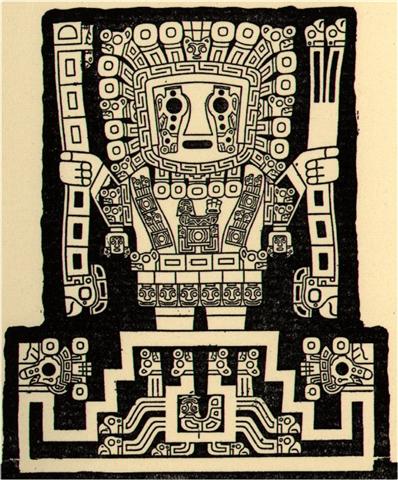
The top layer consists of
what looks like 6
bricks of sundried earth (henua)
and the layer below has 6 faces above
mouths drawn like canoes -
implying water. A possible explanation
could be that the Sun calendar had 6
months of summer heat and 6 months of
cold water.
... They walked in crowds when they
arrived at Tulan, and there was
no fire. Only those with Tohil
had it: this was the tribe whose god was
first to generate fire. How it was
generated is not clear. Their fire was
already burning when Jaguar Quitze
and Jaguar Night first saw it:
'Alas! Fire has not yet become ours.
We'll die from the cold', they said. And
then Tohil spoke: 'Do not grieve.
You will have your own even when the
fire you're talking about has been
lost', Tohil told them.
'Aren't you a
true god! Our sustenance and our
support! Our god!' they said when they
gave thanks for what Tohil had
said.
'Very well, in truth, I am your god: so
be it. I am your lord: so be it,' the
penitents and sacrificers were told by
Tohil. And this was the warming
of the tribes. They were pleased by
their fire. After that a great
downpour began, which cut short the fire
of the tribes. And hail fell thickly on
all the tribes, and their fires were put
out by the hail. Their fires didn't
start up again. So then Jaguar Quitze
and Jaguar Night asked for their
fire again: 'Tohil, we'll be
finished off by the cold', they told
Tohil. 'Well, do not grive', said
Tohil. Then he started a fire. He
pivoted inside his sandal
...
The Weeping God was evidently standing
on horizontal 'bricks' in the night,
whereas the rongorongo text had them
oriented vertically and indicating
daytime units:
 |
|
henua |
During these 6 months of
cold water (the 'winter year') the Moon
could have ruled (6 * 29½ = 177 = 360 - 183)
because the Sun was absent (on the other
side of the equator together with his
fishy winter maid).
... Hamiora Pio once spoke as
follows to the writer: 'Friend! Let me
tell of the offspring of
Tangaroa-akiukiu, whose two
daughters were Hine-raumati (the
Summer Maid - personified form of
summer) and Hine-takurua (the
Winter Maid - personification of
winter), both of whom where taken to
wife by the sun ... Now, these women had
different homes. Hine-takurua
lived with her elder Tangaroa (a
sea being - origin and personified form
of fish). Her labours were connected
with Tangaroa - that is, with
fish. Hine-raumati dwelt on land,
where she cultivated food products, and
attended to the taking of game and
forest products, all
such things connected with Tane
...
All around
Pachamama we can count 'fish eyes'
in her skirt:
... The principal word for 'fish' in
most Dravidian languages is min,
which has an ancient homophone meaning
'star', both probably derivatives of the
root min 'to glitter' ... Fish
are actually unable to close their eyes,
and the fact that 'when the fish sleeps
it does not close its eyes' was noticed
by ancient Indians. The dot-in-a-circle
similar to that occuring among the
trefoils of the Harappan priest-king's
robe is identical with the eye of the
many small hare- and fish-shaped amulets
discovered on the lower levels of
Harappa
...
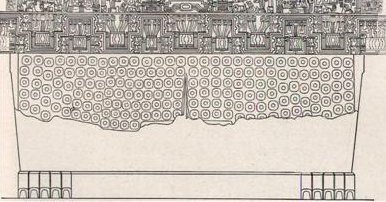
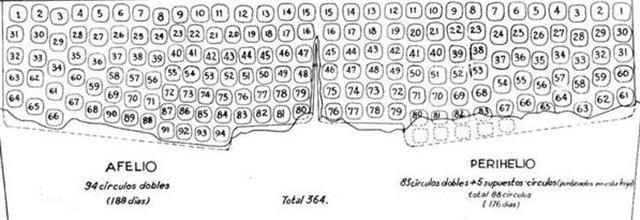
Posnansky has here counted to
83 (her left side) + 94 (her right side) = 177
'fish eyes' and then suggested we should
count them twice in order to convert
them
into number of days.
However, the right side
part of her skirt has been broken off,
as if by accident, and Posnansky
therefore assumed we should add 5 now absent
double days: 88 (her left side) + 94 (her
right side) = 182 and then 2 * 182 = 364.
But I suggest we should
instead keep
to what was intended to be visible and count 2 * 94 + 2
* 83 = 188 + 166 = 354 (= 12 * 29½).
South of the equator -
below the midline as in the Polynesian
homeland - Moon ruled their calendars
and it was all very easy. But up in the
north it was extremely complicated:
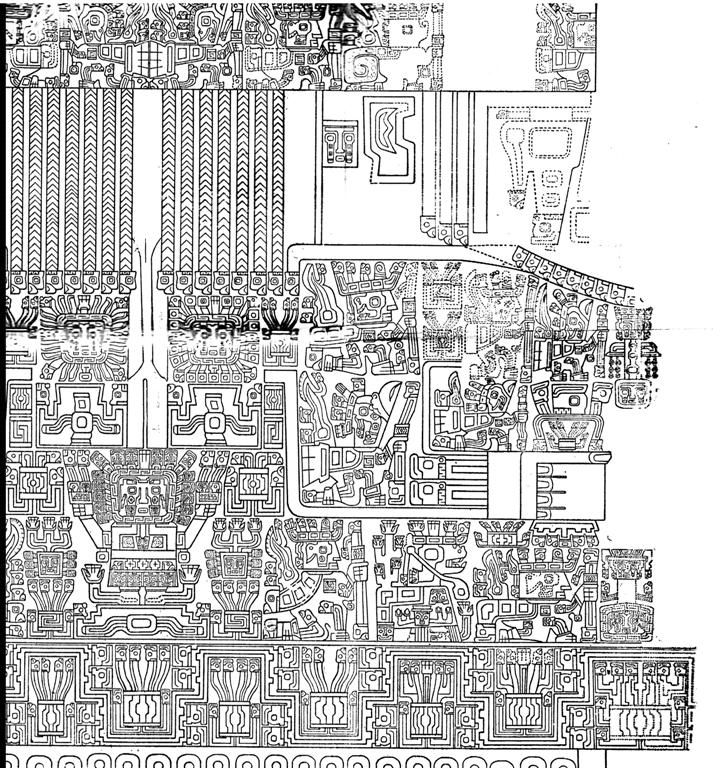
Furthermore, Posnansky
has counted his circulos dobles in
a way which resembles the serpentine
rows on a rongorongo table - however not
ascending upwards.
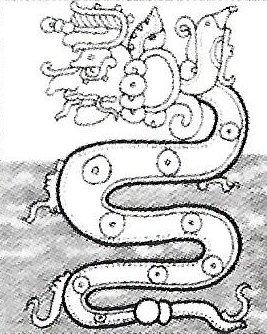
In the beginning
everything is simple but later it
becomes complicated and counting should
therefore
proceed upwards.
... According to an etiological Hawaiian
myth, the breadfruit originated from the
sacrifice of the war god Ku.
After deciding to live secretly among
mortals as a farmer, Ku married
and had children. He and his family
lived happily until a famine seized
their island. When he could no longer
bear to watch his children suffer, Ku
told his wife that he could deliver them
from starvation, but to do so he would
have to leave them. Reluctantly, she
agreed, and at her word, Ku
descended
into the ground right where he had stood
until only the top of his head was
visible. His family waited around the
spot he had last been, day and night
watering it with their tears until
suddenly a small green shoot appeared
where Ku had stood. Quickly, the
shoot grew into a tall and leafy tree
that was laden with heavy breadfruits
that Ku's family and neighbours
gratefully ate, joyfully saved from
starvation ...

|














